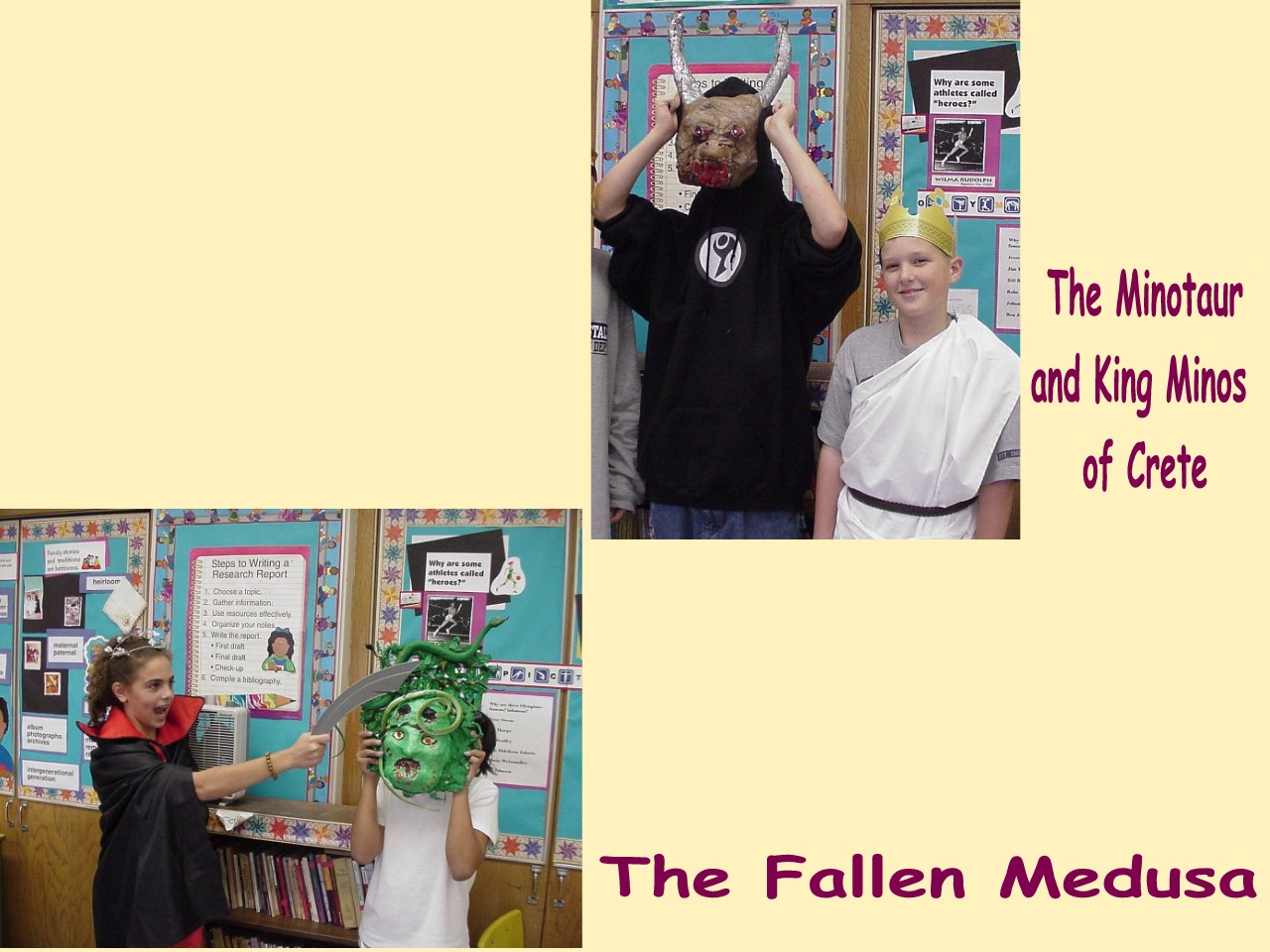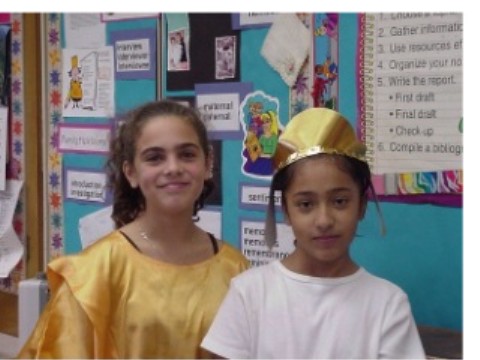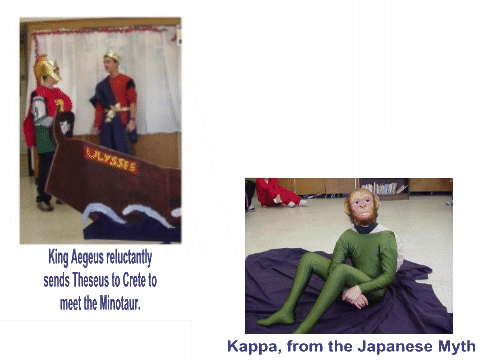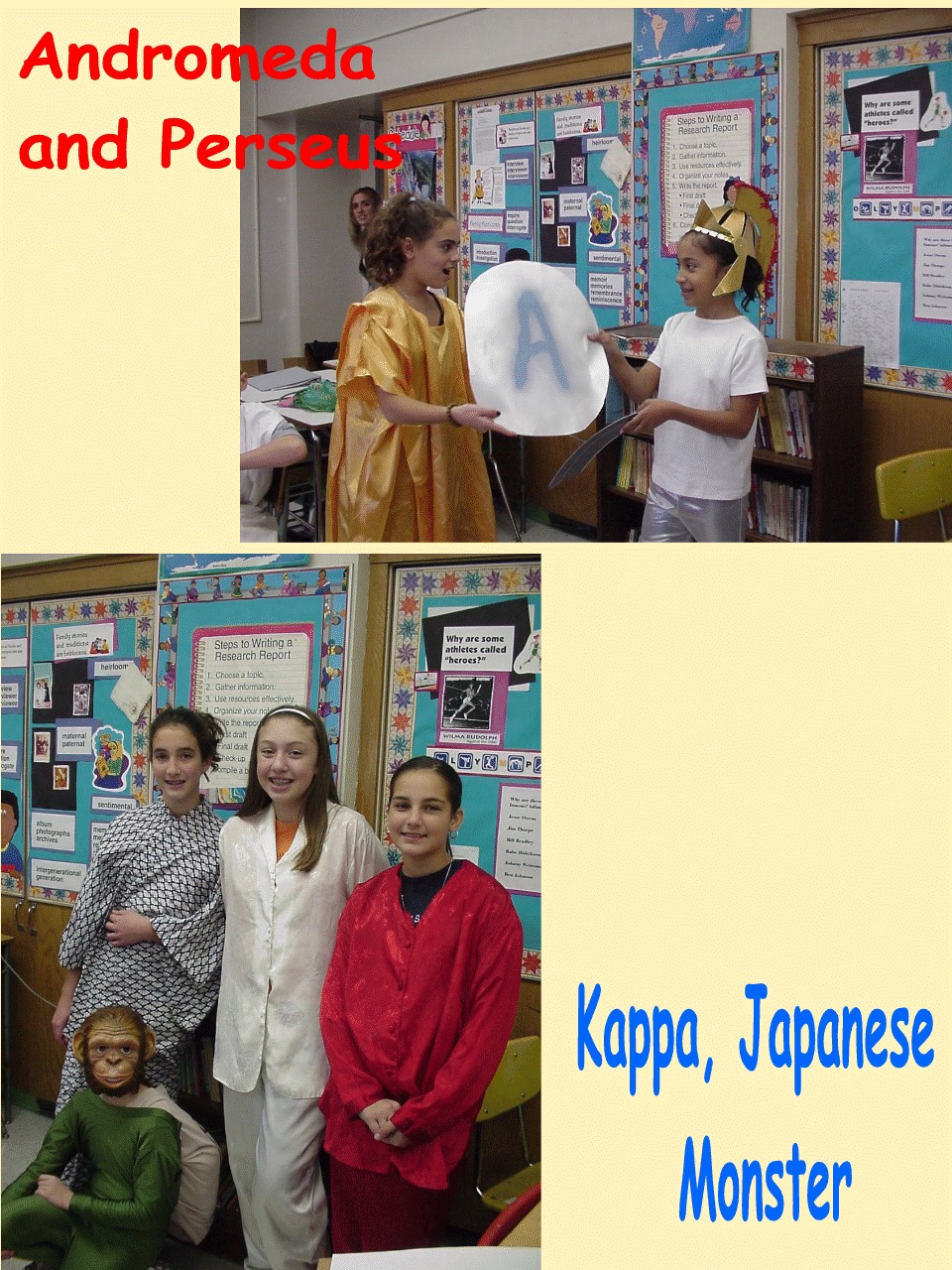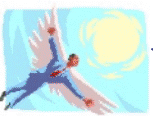 Monsters
& Myths: Scripts
Monsters
& Myths: Scripts | LESSON PLANS | RELATED INTERNET LINKS | PHOTOS |
| ENRICHMENT | MYTHMAKING | FANTASTICAL CREATURES |
![]()
.
Students will recognize myth as a unique genre of literature. | |
Students will learn how these myths were once shared by ancient storytellers in an oral tradition. | |
Students will relate their reading to Social Studies learning re ancient cultures, myths, and explanations of phenomena. | |
Students will compare myths from varied cultures with same theme. | |
Students will utilize graphic organizers to aid critical thinking/comprehension of stories. | |
Students will write an original myth using readings as model. | |
Students will read dramatizations of mythic tales in readers theater style. | |
Students will write and perform dramatizations in collaborative peer groups. |
Reading
Read 25 books.
Writing
Produce a response to literature
Produce a narrative account
Speaking, Listening, Viewing
Participating in group meetings.
Making informed judgments about media.
Conventions, Grammar, Usage
Demonstrating an understanding of the rules of English language
Analyzing and revising work
Literature
Responding to fiction, drama.
Producing work in a literary genre.
Students will write original myths using the word processor.
Students will research the Internet using search engines, electronic encyclopedia, etc. for information for their plays' content..
Students will use graphics program [Inspiration software], i.e. semantic web, to compile notes for group project.
Students will transpose stories of mythic monsters to plays in groups using the word processor.
![]()
Aim: Why were myths created?
Motivation: [Introduce unit - relate to prior knowledge using semantic web.] Show familiar character in 3 illustrated books. Ask students to share their knowledge of the Greek Hero from what they've read, heard and seen on TV and in the Disney animations. After brainstorming relate to mythology. Create a semantic web.
Development:
1. Motivation.
2. Semantic web - sharing understandings of why myths were created.
3. Formulate a definition - write on board w/ class. Compare with textbook definition. Copy into notes.
4. Introduce book: Hercules and the 12 Labors - one of several versions available (Books are lined up on chalk ledge)
6. Introduce students to Hercules problem and his punishment by reading beginning aloud.
7. Introduce chart for notetaking - 3 columns
LABOR/PROBLEM SOLUTION BRAINS OR BRAWN
8. Students read three labors from Adventures for Readers [Harcourt Brace] completing the chart - Noting and summarizing each problem and Hercules' solutions. Then, deciding whether he used brains and/or brawn to solve the problem.
9. Groups discuss charts - compare notes and ideas.
10. Groups share with whole class discussion.
Homework: Complete the reading and take notes on chart.
![]()
Aim: To compare versions of Hercules story to recognize how stories of oral tradition change. To critique - which is preferred and why.
Motivation: Show 2nd and 3rd versions of the tale -- immediate interest from varied illustrations. Have students share differences between Disney version and the readings. Read aloud 2 excerpts from different books. Students listen and take note of differences.
Development:
1. Motivation.
2. Aim.
3. Compare notes - discuss.
4. Review & critique -- offer models.
Summary:
Why are there different versions of the Hercules story?
Why is it good to read several versions?
Homework:
Read "Prometheus the Fire Bringer" [in Adventures]
![]()
Aim: Comparing three fire-bringer myths to enrich critical thinking ability and foster comprehension.
Motivation: (Lesson 3) Review graphic organizer using demonstrating with 2 fruits (orange and apple) - elicit shared and differentiated characteristics, plotting on the diagram.
Present overhead image of comparative myths on screen [Create using Inspiration Software]. Distribute black and white copy to students for their notetaking.
GRECO ROMAN & NATIVE AMERICAN

Development:
1. Motivation.
2. Aim on Board.
3 Place "Fire Bringer" in center of intersecting circles. Students discuss stories in pairs, filling in the circles accordingly comparing stories.
4. Read aloud Nez Perce Native American Myth, "The Origin of Fire" [McDougal, Littell Literature Red Level]. Students take notes regarding story line, etc.
5. Students discuss story/compare with peers in groups. Plot comparisons on large chart paper... together with classmates using Venn Diagram.
6. Discuss with entire class... groups share during Debriefing.
Summary: Why did these two cultures believe these stories?
Homework: Read third myth relating to "how fire came to man." African myth "How Humans Got Fire" in Literature Anthology [McDougal, Littell Literature Red Level].
![]()
Aim: To read a third, related myth that comes from another culture, in another part of the world, Africa.
Motivation: Using a three circle Venn Diagram to establish varied features of balls used in sports (football, basketball, tennis ball). How are they alike/different? Drawn on board... compare features/plot responses. How might we use this diagram to help us to understand three fire-bringer myths? Elicit aim.
Development:
1. Motivation.
2. Aim on board.
3. Have students retell the African myth from homework reading.
4. Present overhead image of comparative myths on screen [Create using Inspiration Software]. Distribute black and white copy to students for their notetaking.
NATIVE AMERICAN GRECO ROMAN AFRICAN
5. Question: Why do we need to rewrite/rethink the first diagram's responses? Why can't we just leave the two columns and add a third. Discuss.
6. Ask students to work in groups on another piece of chart paper comparing and contrasting the three myths. They may use the first chart for notes to aid them.
7. Students may use textbook and journal entries or notes for aid during the task.
Summary:
How are the myths alike? How do they differ significantly? What conclusion can we draw from the similarities among the three diverse cultures' myths about humans getting fire? Why are myths important to cultures?
![]()
Aim: How is a play different from prose? To read the Greek "Icarus and Daedalus" in both prose and play forms.
Motivation: Before play, read aloud Wings by Jane Yolen, a short illustrated version of the myth. Today we are going to read another version of this story in play form. Aim.
Development:
1. Introduce the aim.
2. Review the purposes of Readers Theater. How is readers theater different from a stage play? Elicit: readers theater is simple reading aloud without costumes, props, staging, scenery, etc.
3. Draw columns on the board. Use the following labels for column subtopics: STORY PLAY
How are prose story and drama/script alike? Elicit: both tell same story. How are they different? Elicit: Prose read in point of view with dialogue as an enhancement. Plays tell the story in many voices; majority is in dialogue with a minimal amount of prose via the narrator. Discuss. Write notes in LA Note Book.
4. How will the players have to prepare in order to perform the play in readers theater? Elicit class rules.
5. Discuss external organization. Stage directions, narrator's role, scenes, acts, etc. Equate them to prose chapters, narrator, sections, etc.
6. Select students to read - involve as many as possible.
7. Read play aloud.
8. Students write 5 minute quick write response in journals re the story and its purpose or meaning.
9. Students discuss their journal entries with fellow students in groups.
10. Class discusses altogether; compares to story Wings read previously. Note remarks in two columns on board.
Summary: How are plays and prose stories alike? different?
![]()
Aim: To create an original myth that will explain a phenomenon and calm the people.
Motivation: Create the following imaginary scenario. Relate to students - giving them a role to play and a purpose for their writing. We have discovered a portal to time travel. You find yourself in an unusual setting, not unlike the places we have visited in our imaginations in this unit on mythology from various cultures.
You are a wise, respected leader of your cultural community living in an ancient setting. To explain a phenomena that has frightened the people, you must create a story that will calm them and give them a logical explanation for the circumstances of their situation. Write an original myth that might be presented. Remember you are a storyteller.
Development:
1. Motivation.
2. Aim on board.
3. Students' portfolios are distributed.
4. Review literary elements in myth.
5. Students write using the writing process.
6. Students share with peer editors. Discuss their stories.
7. Students rewrite based on editors' remarks, constructive criticism.
8. Students have opportunity to share, illustrate, publish using word processor.
Summary: Why were myths created? How did ancient storytellers learn about these myths and pass them on? Elicit: oral tradition.
![]()
Aim: To research mythic monsters using the internet to find a story to transpose to a play to be shared with the members of the class. In addition, groups will sculpt masks or models of the creatures in art - to be used in plays. See related Lessons
Minotaur |
Cyclops |
Unicorn |
Kappa |
Sirens |
Medusa |
Sphinx |
Fire-Bringers |
Motivation: Lottery for choice of topic. Routine: Place 7 names of mythic monsters on large oaktag cards. Post on board while telling something brief about the monster and why it is famous in mythology. Students listen to decide which of these creatures they would like to learn more about, researching the internet and books. Students place names in priority order in notebooks. Lottery is conducted. Only 5 students (Maximum) in a group. Students select based on their draw. Groups closed after 5 and students must select second or third choices, consequently. How can we find out more information about the creatures, what they looked like and their adventures and related heroes? Elicit: Research. What research tools should we use? Elicit: Internet, encyclopedia, books, etc.
Development:
1. Motivation.
2. Aim on board.
3. Lottery is conducted. Names are written in lists under names of creatures.
4. Groups meet to discuss research strategies. Who the internet team (Pair) will be; who has access at home as well and can assist in the internet research.
5. Teacher reviews internet search engine use/process; keywords; narrowing search, etc. See related Library lesson
6. Groups meet for the first time to share prior knowledge and ability to access information sources. Groups set agenda for second meeting.
Summary: How will we proceed to find information on the mythic monsters for our plays?
Homework: Begin research. Take notes, bring to class groups.
Aim: To locate stories related to the mythic monster in order to select one for the drama.
Development:
1. Review research procedures.
2. Discuss note taking strategies.
3. Present overhead projection of graphic (below) for student note taking. Note place for web addresses (Introduce vocabulary: URL)
4. Distribute student work sheet copy of graphic.
5. Using the Inspiration Software, students compile information/notes on creatures.
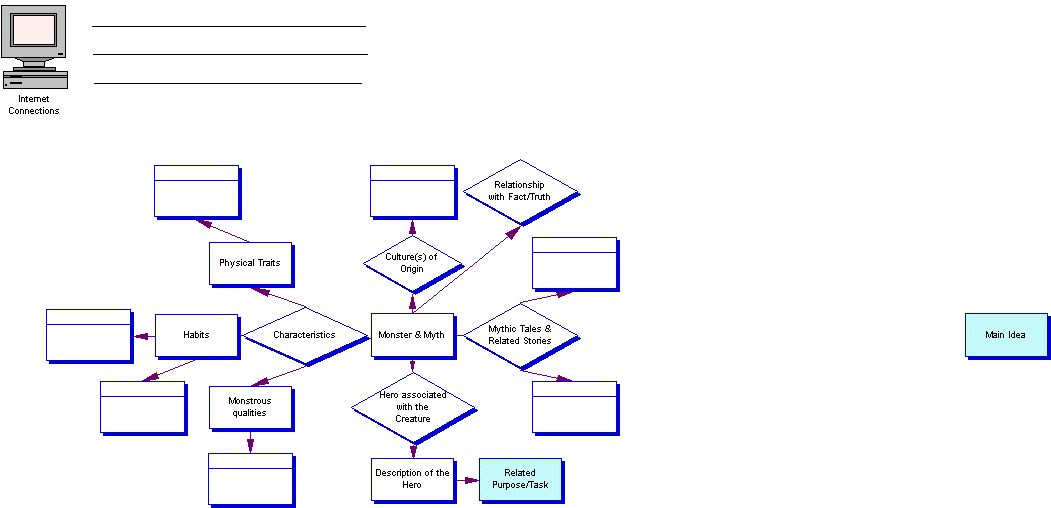
6. Students utilize classroom resources, Internet sites recommended by teacher.
Summary: How can we find and record information concerning our topics?
Aim: To use notes gained in research to develop a script based on topic to be presented to the class.
Motivation: How do you think movie directors organize their shoots when they are planning their filming? Discuss. Elicit: outline a plan, etc. Show examples of storyboarding from video of recent special on Chuck Jones, the animator... show the clip featuring the storyboarding technique used by him as a director for Road Runner Cartoons. Present visual of a storyboard on the screen (Inspiration Software).
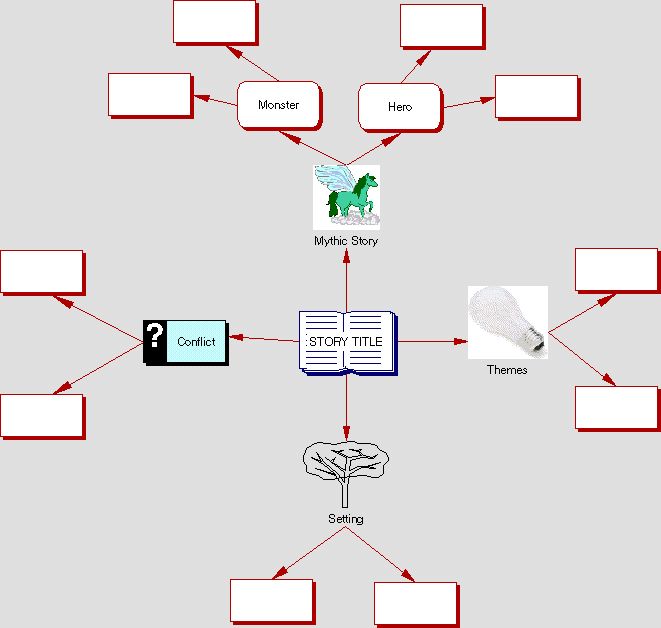
Development:
1. Review story elements. Discuss transition to play from prose writing.
2. Motivation.
3. Aim.
4. Distribute student copy of the graphic.
5. Groups work to synthesize their notes.
6. Begin to create story boards using process discussed previously.
7. When storyboard is completed, students are ready to write scripts.
Summary: How does storyboarding help us to write scripts? How do plays effectively tell stories?
Aim: To transpose storyline to script format.
Motivation: How will our plays help others to understand the story? Discuss. Where are we now in the process? What do we need to do next? Aim.
Development:
1. Motivation.
2. Aim.
3. What will we need to include in the play to ensure the viewers/readers comprehension of the story? Elicit: Scenes, acts, dialogue, stage direction, narration, etc.
4. Review purposes.
5. Explain that students can use other plays as models to help them with the format of the script.
6. Direct students to focus on the script writing only. Costumes, props, scenery, etc. can be organized/discussed tomorrow.
7. Students write plays together. All members must have a part/role.
Summary: How will our plays communicate story to the reader/viewer?
Aim: Why should we use costumes, scenery, and props in our plays?
Motivation: Show picture of the two masks used in Greek Plays (Comedy and Tragedy) What are these? Elicit: Masks. IF no one knows background, explain their use/purpose. Describe the amphitheater... show pictures from books. Have internet hooked up to site of ancient amphitheater for students to see. Explain the use of the platform and "Deus ex machina" as a stage prop to communicate intervention of the gods in the Greek theater. Why should we use costumes, scenery, and props in our plays? (Aim)
Development:
1. Motivation.
2. Aim.
3. Discuss use of simple classroom objects and everyday materials added to imagination to present ideas... example, student riding chair backwards to simulate riding horse; flickering of lights to simulate lightning (Zeus)... etc. Ask for other examples.
4. Direct students to brainstorm lists of materials, costumes, etc. to be used for plays with their peer groups.
5. Offer use of overhead, cassette or CD player and any other materials they may need.
6. At end of meeting hold debriefing re needs/desires... create list.
7. Discuss who will be first to present dramatization. Draw schematic of stage layout... audience in arch shaped amphitheater style. Audience in costumes as well.
8. Offer materials in storage closet including paper helmets* (Trojan style) - acquired from Oriental Trade* Company; felt costumes for soldiers to wear with helmets, etc.
Aim: To design a program for the audience.
Motivation: Show 3 or 4 programs including Broadway show Playbills and one from a production in Athens. Who knows what these are? Where do you purchase them? How are they used? Why are they an important tool? How will our creation of a program for our plays aid our audience? Aim.
Development:
1. Motivation.
2. Aim.
3. Students design program and type it using one of the following programs: Print Shop (Greeting Card Design); Microsoft Home Publisher; ClarisWorks; other
4. Discuss use of landscape vs. portrait design in page set up.
5. Show samples. Delineate parts: Introduction, summary of story, list of characters (in order of appearance), etc. and actors
6. List criteria/requirements as checklist.
7. Students design and create cover and contents.
Summary: How will our creation of a program for our plays aid our audience?
Aim: How can a play communicate story to the viewer/reader?
Motivation: Inherent in costuming and performance.
Development:
1. Before the performance, rearrange desks, etc. to amphitheater setting. Stage curtains pinned to back boards.
2. Time should be given for each group to organize, stage, etc. before the presentations.
3. Audience should be actively listening. Review rules for polite and appropriate audience deportment.
4. Plays are performed over the course of two or three class sessions (depending on length, staging and readiness)
5. Plays should be video taped for groups to later self-evaluate.
6. Photos should be taken with digital camera - of costumed players as a repertory group [later posted on bulletin board with their group names]. Can be posted with copies of the program.
Summary: How do plays help us to communicate story? Why are they so powerful?
![]()
When? Festival is conducted on the last day. Celebrating all accomplishments. | |
Who? Parents, administrators, and collaborating teacher are invited. | |
What? All students should receive certificates of accomplishment for their participation in the unit's activities at the celebration/gala on the last day. | |
How? Hospitality: Foods should have a mythological connection. Example: Ambrosia (food of the gods), Bulls eye cookies (Minotaur), etc. A punch can be concocted using fruit nectars (food of the gods) and sparkling soda. | |
Features: Published book is unveiled for the first time.Sculptures are displayed around the room, as are photos of the players, etc.The video tapes run from other days' performances at several VCR sites. |
Ongoing and appropriate measures of student progress include: | |
Student self-reflection and self-evaluation regarding individual and group progress and productivity. | |
Teacher made tests. | |
Student self-evaluation of video after the performance. | |
Teacher observation of individuals' participation in group activity (Kidwatching - using anecdotal records) | |
Portfolio assessment - reviewing with student (1) reader responses in log, (2) original myth, (3) written scripts, (4) notetaking on graphic organizers, etc. |

![]()
Related Fire-Bringer Myths
|
Mythic Monsters on the Net |
Minotaur
Bulfinch Mythology - The Minotaur in Classical Mythology - overview http://english.uiuc.edu/maps/poets/m_r/rukeyser/minotaur.htm
Greek Mythology Link - Gives synopsis with links to fine art images and sculptures of characters in tale http://homepage.mac.com/cparada/GML/
Myth of Daedalus & Icarus - line drawings and retelling http://island-ikaria.com/myth.htm
Minotaur of Knossos - Story with ties to the Palace in Crete & archaeological links http://web.ukonline.co.uk/conker/weird-beasts/minotaur.htm

Anthropological link - Was there such a person? "The Real Cyclops" http://users.globalnet.co.uk/~loxias/odyssey/cyclops02.htm
John Turner's (1775-1851) Oil Painting of "Ulysses deriding Polyphemus" http://nationalgallery.org.uk/cgi-bin/WebObjects.dll/CollectionPublisher.woa/wa/work?Number=NG508
Retelling of the story from an anthology - Illustration from a class "The Cyclops's Cave" http://lrs.ed.uiuc.edu/students/mmarassa/mythology/cyclops.html
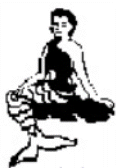
Tunisian mosaics depicting tale http://tunisiaonline.com/mosaics/mosaic34.html
Waterhouse Painting of story (1891) Sirens http://wings.buffalo.edu/academic/department/AandL/classics/epicpage/sirens-w.html
Retelling "The Odyssey vs. Ulysses "The Cyclops" http://whoosh.org/issue17/stephen1.html
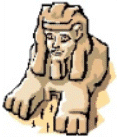
Greek Sphinx & Riddle of synopsis http://loggia.com/myth/sphinx.html
Egyptian Sphinx art, history, representations in literature: http://nmia.com/~sphinx/egyptian_sphinx.html
Greek Sphinx: art, history, literary representations/meaning http://nmia.com/~sphinx/greek_sphinx.html
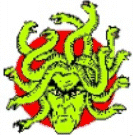
Medusa: art works depicting slaying of the gorgon by Perseus http://humanities-interactive.org/ancient/myth/ex051_11.html
Cellini's sculpture of Perseus with the head of Medusa - Wonderful photographs of the 14th Century sculpture http://bluffton.edu/~sullivanm/lanzi/lanzi.html
Photograph of an ancient ceramic urn depicting Perseus offering Medusa's head to Athena http://bama.uaedu/~ksummer/c1222/LECT14/sld007.htm
Perseus Adventures - overview http://greekmythology.com/Myths/The_Myths/Perseus/perseus.html
Story of Perseus and Medusa with pictures http://thanasis.com/perseus.htm
Photo of a sculpture of Medusa's head http://thanasis.com/medus3j.jpg
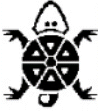
Japanese mythology linking shinto to Kappa http://his.com/~tkuster/myth/shinto.htm
Synopsis of character attributes/origin Kappa http://shannonswebdesigns.com/Japan/Gods_Goddess.html#Kappa

Unicorn site - myths and legends www.erc.msstate.edu/~allison/uni.html
Relates several synopses of Unicorn legends from various cultures http://geocities.com/Area51/Corridor/4378/legend.html
![]()
